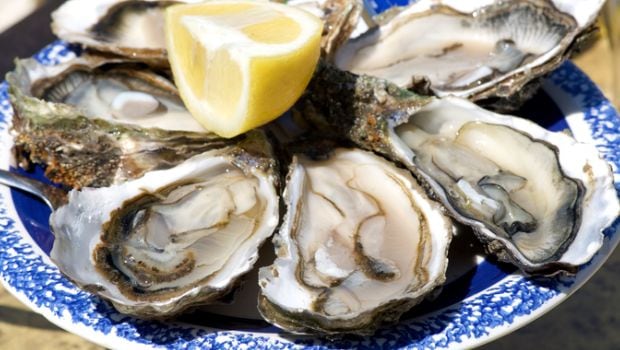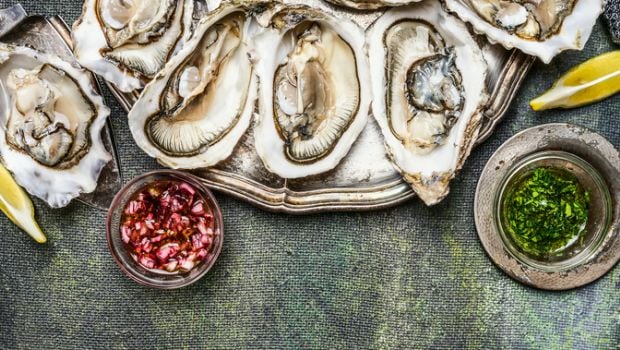
It isn’t surprising to come across people who refer to oysters as ‘overrated’. The argument put forth is that why should one pay such a steep price for a few shells when they taste nothing more than salt water. Yet we all know that it is a prestigious ingredient in the world of fine dining, so that builds up the curiosity nevertheless. There has to be some reason, isn’t it?
If you have travelled along the coastline of France or visited a few coastal cities in the USA, Australia, UK, Caribbean, et al, you realise that shell fish, particularly mussels and oysters, are a given. No one turns a head if you order a plate of oysters. Instead you are spoilt with multiple options to delight your taste buds. And then, you start to unravel all the frills to discover the humble ingredient for what it’s really worth. It is “a taste of the sea” but definitely more than just salt water.
Oysters – A Taste
Oysters, also known as bivalves, are salt water molluscs containing two shells adjoined on one end. They are usually found in marine or brackish water, and epitomises what’s known as “taste of place”, where the natural environment plays a significant role in the flavour of the ingredient. In the case of oysters, the salinity of the sea water, temperature, planktons they graze on, etc. all contribute to its taste.
On the surface and for first timers, oysters may taste exactly the same as sea water. But as you explore various terroirs or “merroirs” (the marine reference) you start to understand the complexity – there are various types of oysters with unique characteristics and flavours depending on the region they hail from. Therefore most kinds come with an affix of the region, example Kumamoto – Oakland Bay or Atlantic Oysters – Fanny Bay.
Similar to wine, oysters too come with their set of flavour notes. They can be floral, fruity, spicy and even like mushrooms. Some terminologies that connoisseurs are familiar with include briny, sweet, nutty, buttery, cucumber, melon, watermelon, seaweed, creamy, mineral, springy, plump and meaty. So yes, it is complex.
“Like wine, oysters mirror their natural environment and draw overall flavour from the waters in which they live. There’s the pure, sharp brininess of Atlantic oysters and the sweeter, kelpier smoothness of Pacific oysters. Aquatic micro-zones contribute the subtle flavour attributes. These highly individualized environments are the reason you hear so many different words used to describe the way oysters taste, look, and feel. Sublimely balanced Island Creeks. Sweet, fruity Hama Hamas. Creamy, herbaceous Hog Island. Perfect, buttery Kumamotos. Earthy Olympias. Brassy Belons,” note Jeremy Sewall and Marion Lear Swaybill in their book Oysters: A Celebration in the Raw.
Oysters – the Different Types
There are several varieties of oysters available worldwide and most of the commercial ones are cultivated to meet the ever growing demand of diners. Edible oysters can be broadly categorised into six types – Pacific Oyster, Flat Oyster or Belon, Kumamoto, Atlantic Oyster, Olympia and Rock Oysters.
1. Pacific Oyster – it’s small-sized, sweet in flavour, less briny, found along the coastlines of Europe and America though it is said to have been bought to France from Asian Pacific region in the early 1900s, the shells have ruffled edges and it is the most commonly cultivated oyster.

2. Atlantic Oyster – also known as American oyster, has mineral flavour note with a savoury finish, tear-drop shaped shells that are large-sized.

3. Flat Oyster – also known as European Flats or Belon, commonly found in the Brittany region of France, has a smooth and flat shell, distinctive mineral and seaweed flavour note with a meaty texture.
4. Kumamoto – small-sized with bowl-shaped shell, sweet and nutty in flavour, a native of Japan though largely cultivated in US.
5. Olympia – they are tiny-sized, almost the size of a quarter, native to the West Coast of US, sweet in flavour with a metallic note, creamy in texture.
6. Rock Oyster – popularly known as Sydney rock oyster, is small sized, sweet and fruity in flavour, and chewy in texture.
How to Enjoy Oysters
“Like sushi, oysters are best eaten raw, when the living chi has not yet fled. They have a life force in them that leaves you feeling flushed. And you will pay what it takes to get that feeling. That’s why oysters, nutritional nobodies, can cause people to part from their economic senses…” says author Rowan Jacobsen of The Essential Oyster: A Salty Appreciation of Taste and Temptation.
The best way to enjoy oysters is to have them au natural – fresh and raw. It is a delicacy that you can savour at respective regional coastlines known for their oysters. A squeeze of lime, a dash of Tabasco or a drizzle of mignonette sauce with shallots and vinegar is all you need to elevate the flavour. While it may sound primal or just plain disgusting, some things are bet savoured as they are.

Other than that, oysters are also used in making fritters, as fillings, bakes, grilled, etc. In India, you can find oysters along the coast of Kerala, where the locals prepare it with local spice mixes to make stir-fries and curries. So gear yourself and get a taste of the sea. You’ll surely be in for a pleasant surprise.





